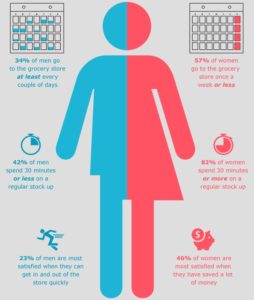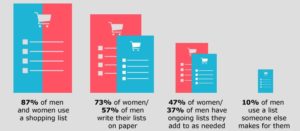He shops, she shops.
By Rebecca Streightiff and Dave Brazier
Grocery shopping. A few decades ago, it was a household task performed mostly by women. However, as times and lifestyles have changed, it’s clear that a lot more men are driving the cart. According the NPD group, men are the primary shoppers in 41 percent of households. In a recent survey by Men’s Health, 84 percent of readers reported that they’re the primary shoppers in their households.
Although both sexes may be doing the shopping, is there a difference in the way they go about it? We wanted to dig deeper to understand the similarities and differences.
He shops, she shops:
Who’s Driving the Grocery Cart?
Women are still more likely to consider themselves the primary grocery shopper, but the activity has become more gender neutral.

Men on a Mission, Women on a Journey
Generally speaking, men and women seem to have different goals when they grocery shop. Men want to get what they need quickly and therefore need to go more often. Women are more thoughtful about the process as they try to meet their needs while also being conscious of how much they’re spending.

Who’s More Committed to Their List?
Women see grocery shopping as more of an on-going commitment and keep a list they add to as needs are identified. They even write it on paper and most likely keep it somewhere handy in the kitchen. Men use a list too, but sometimes somebody else makes it for them.

What does this mean for marketers?
1. Consider an always-on approach to targeting male shoppers.
A classic Thursday insert may be useful for once-a-week stock-up shoppers; mission-based shoppers will find it more valuable to receive marketing content throughout the week and closer to the point-of-purchase. An online ad they see that day may prompt them to buy the items they plan to eat that night.
2. Enhance rewards programs with benefits that add convenience.
Consider features like pre-populated shopping lists based on purchase history, alerts when favorite items are on sale and ‘refill’ notifications via text when it’s time to replenish supplies. Want to make the most of low traffic periods? Allow shoppers to sign up for SMS or app-based alerts when store traffic is low (and checkout is especially speedy).
3. The easier the better for men.
Target men using in-store marketing such as impulse item displays, ‘mini convenience stores,’ and to-go stations. Better yet, eliminate the schlep all together by offering convenience-based shoppers order-ahead pickup or grocery delivery service.
More Insights
- October 3, 2017 Working with Snoopy.
- August 18, 2017 Our C-K Creator Summer 2017 interns made friends for something they believe in.
- June 23, 2017 The C-K June 2017 playlist.
